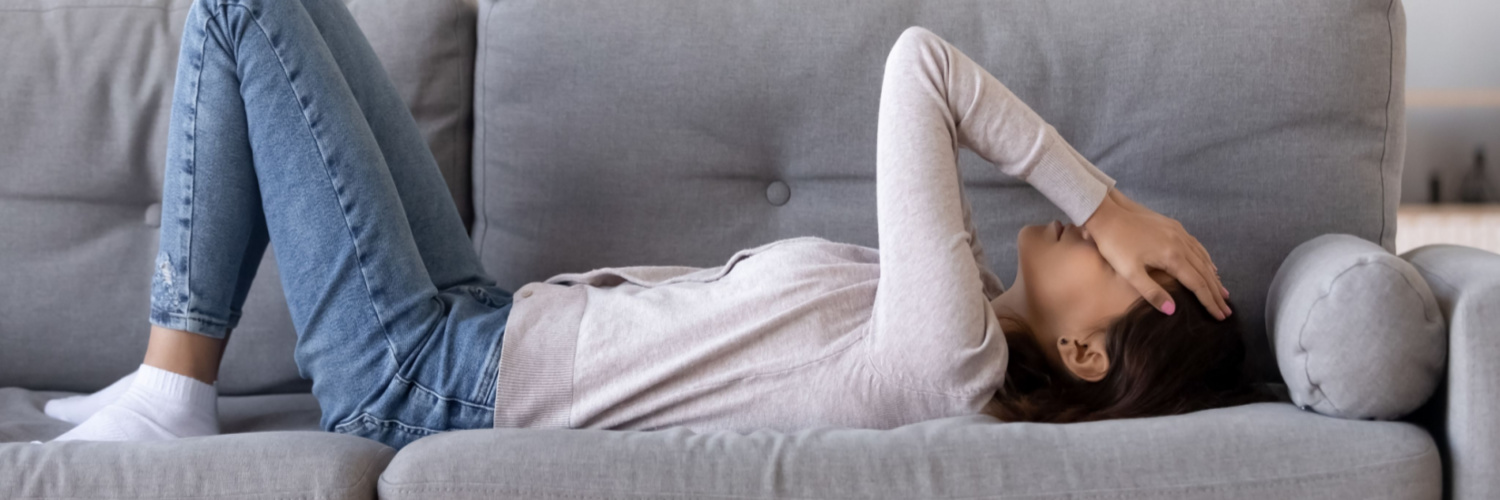
Everyone, regardless of age, will experience anxiety from time to time. Anxiety is a natural and common human emotion that arises for several reasons. Typical causes of anxiety may include certain people, situations, places, or events that cause concern or worry about what the next few minutes or hours may hold. Daily life events can also induce anxiety. For teens, this may include starting a new school, taking a big test, applying for college, or even going on a first date. Anxiety often diminishes once the situation that led to stressful feelings is over. For teens who experience symptoms of an anxiety disorder, including panic attacks, this may not be the case.
Understanding Anxiety and Panic Disorders
While anxiety is an expected and entirely normal emotion in many situations, there may be times when your teen’s anxiety evolves into overwhelming fear or terror. Typically, these symptoms are impossible to control and out of proportion to the actual danger that may occur at the time. These feelings of worry and concern can cause your teen to actively avoid events, people, and places (including activities, school, hobbies, and friends) that they feel may lead to anxious feelings. Some teens may choose to dull their symptoms through self-medication using alcohol or drugs. This practice, although not limited to adolescents and teens, can lead to many other medical and mental health challenges, including those related to substance use disorders and addiction.
What are Panic Attacks?
The DSM or Diagnostic and Statistical Manual for Mental Disorders provides detailed diagnostic criteria many mental health providers use when assessing and diagnosing anxiety and panic disorders. Although there are several types of anxiety disorders, some types are more common among the population than others. One such diagnosis is panic disorder. Panic disorders are a specific type of anxiety disorder. If your teen experiences symptoms of a panic disorder, they will experience frequent and (generally) unexpected episodes of overwhelming fear. In addition to fear, they will experience physical symptoms like stomach problems, a racing heart, and difficulties breathing.
The above symptoms describe the physical symptoms of a panic attack. Depending on the intensity and severity of the episode, a panic attack can be terrifying and debilitating. Some teens experience such severe panic they feel “out of control” of body functions. Many believe they are suffering a medical emergency such as a heart attack or respiratory arrest.
Panic attacks often come on quickly and suddenly. Usually, there is a minimal warning or apparent cause for your teen’s symptoms. Unfortunately, because of the unpredictable nature of panic attacks, they can occur at any time, including in potentially dangerous circumstances, such as when your teen is driving the car. They can also occur in cases that would otherwise be considered harmless or benign, such as sleeping, watching a movie, sitting in the classroom, or spending time with friends.
Panic attacks vary in severity and intensity. Your teen can experience all types of panic attacks ranging from mild to overwhelming and incapacitating. Often, the symptoms of a panic attack we’ll begin and then resolve within minutes, leaving your teen feeling exhausted and sometimes confused and scared. Understanding the potential causes or triggers of panic attacks is essential to help your teen predict when one could occur.
Top Five Causes of Panic Attacks in Teens
As with many mental health conditions, research has yet to uncover a single cause for teen panic attacks. Instead, researchers believe a combination of several factors could increase the likelihood that your adolescent or teen may experience panic attacks. Examples may include one or a combination of the following.
Genetic and hereditary factors
Like many anxiety disorders, panic disorders “run in families.” This means children often inherit anxiety disorders and panic disorders from their parents. In fact, panic disorder is usually found in combination with other hereditary disorders such as alcoholism and bipolar disorder. However, it is important to remember that people without a family history of panic disorder can also develop symptoms. In addition to hereditary factors, it is also believed that malfunctioning in specific areas of the brain such as the amygdala and adrenaline glands may cause an overproduction of certain chemicals which can lead to the physical symptoms of a panic attack.
Phobias
Another potential cause of panic attacks is phobias. Phobias are “persistent, unrealistic, and excessive fear of an object, animal, person, activity, or situation.” Some phobias are very specific and limited (such as a fear of spiders or cats). In contrast, others are broader and can lead to difficulties in various scenarios. For example, symptoms of acrophobia (the fear of heights) can be triggered by looking out the window while driving over a high bridge, or claustrophobia (fear of confined spaces) can be triggered by riding an elevator or being in a small area. There are several types of phobias; however, many can lead to notable lifestyle complications and severe anxiety. For some, exposure to the source of their phobia can trigger a panic attack.
Emotional triggers
Certain emotional triggers may also increase levels of anxiety and panic in teens. Experiencing a traumatic or stressful life experience such as losing a loved one or friend can trigger intense emotions that can be difficult to manage. This can lead to elevated anxiety, which in turn can lead to panic attacks. Other emotional challenges such as low self-esteem and other mental health difficulties that often accompany teen growth and development can lead to anxiety symptoms. When left untreated, persistently elevated anxiety levels can evolve into panic disorders for some teens.
Substance abuse
Alcohol or drug use often leads to panic attacks. If your teen has a pre-existing anxiety or panic disorder, using substances can lead to worsening or more frequent panic attacks. Additionally, panic disorder is a risk factor for relapse among those who have achieved recovery from a substance use disorder. It is not uncommon for teens and adults alike who experience panic symptoms to turn to drugs or alcohol to dull the fear, worry, and sometimes terror that accompanies feelings of anxiety and panic. Unfortunately, while relief may occur for a short time, the effects of using drugs and alcohol inevitably lead to the opposite of long-term relief. Some substances, by their very nature, can lead to hallucinations, anxiety, and feelings of worry or panic.
Pre-existing or co-occurring mental health conditions
The symptoms of certain mental health conditions, including post-traumatic stress disorder, obsessive-compulsive disorder, and anxiety disorders, can lead to excessive panic in panic attacks in some teens. Your teen doesn’t need to have a diagnosed panic disorder to experience a panic attack. Many people with post-traumatic stress disorder or other mental health conditions will also experience panic attacks when exposed to specific triggering events or situations.
Treatment For Panic Disorders at Beachside
If your teen has frequent panic attacks, it can be highly debilitating. They may experience limitations that affect their ability to engage in day-to-day activities such as attending class, playing a sport, and enjoying extracurricular activities or other social events like school plays, graduations, or dances. Depending on the severity of their panic, you may notice If they choose to isolate themselves away from friends or family because their symptoms are the least invasive when they are alone or in a safe place. Being away from others in a quiet and secure setting reduces their potential exposure to panic triggers.
Currently, there is no cure for panic disorders in adults or teens. However, several treatment options are available, and with adequate and effective treatment, your teen can learn how to manage anxiety and panic symptoms. A beachside, our caring, compassionate mental health providers address panic disorder using therapy, medications, and sometimes a combination. We will work with you and your family to determine the best course of treatment to help your teen achieve lasting freedom from panic disorder symptoms.
Cognitive-behavioral therapy or CBT is the most common therapeutic model used to address anxiety and panic disorders. CBT aims to help your teen learn healthier ways of thinking, behaving, and feeling when they experience triggering emotions that may lead to a panic attack. The goal of CBT is to help reduce the frequency of panic attacks )or eliminate them) by helping your teen understand how to react in a healthier, safer way to the feelings that occur when they feel panic.
If determined safe and effective for your teen’s particular treatment needs, their treatment providers may also suggest various medications to help reduce the severity of certain symptoms. In most cases, this includes a combination of medications used to treat depression and to control the physical symptoms of panic disorders such as elevated heart rate and overwhelming anxiety. However, some medications may have undesirable side effects and are not suitable for all treatment needs.
It is important to remember that treatment and recovery take time. Regardless of the chosen treatment model (whether psychotherapy alone or a combination of therapy and medication), healing and developing healthier, safer coping mechanisms to manage stressors or panic symptoms is not instantaneous. During treatment, your teen’s provider will help them practice their new coping tools while suggesting potential lifestyle changes that may help reduce the recurrence of panic attacks in the future. Examples of these changes may include exercise, setting a healthy sleep schedule, and dietary changes.
Although symptoms of panic disorders and panic attacks can be complex and challenging to manage without help or treatment, it is vital to remember that panic disorders are highly treatable. At a teen-focused treatment center like Beachside, our caring and compassionate treatment team understands the unique nature of panic disorders in teens. With help and support, your teen can soon be on the road to recovery. Contact our admissions team today to learn more about our programs and how we can help your teen and your family.




